Sustainability of Circular Economy Indicators and Their Impact on Economic Growth of the European Union
Abstract
1. Introduction
2. Materials and Methods
2.1. Research Methodology
2.2. Circular Economy Indicators in European Union Countries
2.3. Research Methodology
3. Results
- H0: H1:
4. Discussion of the Results
5. Conclusions
Author Contributions
Funding
Acknowledgments
Conflicts of Interest
Abbreviations
| EU | European Union |
| EC | European Commission |
| OLS | ordinary least squares |
| PLS | Pooled least square |
| GDP | gross domestic product |
| PPS | purchasing power standard |
| CE | circular economy |
| RRMW | recycling rate of municipal waste |
| EPR | extended producer responsibility |
| CMU | circular material use |
| DMC | domestic material consumption |
References
- European Commission. Innovating for Sustainable Growth: A Bioeconomy for Europe. 2012. Available online: https://ec.europa.eu/research/bioeconomy/pdf/official-strategy_en.pdf (accessed on 14 May 2019).
- Bosman, R.; Rotmans, J. Transition governance towards a bioeconomy: a comparison of Finland and the Netherlands. Sustainability 2016, 8, 1017. [Google Scholar] [CrossRef]
- Carrez, D.; Van Leeuwen, P. Bioeconomy: circular by nature. Eur. Files 2015, 38, 34–35. Available online: https://biconsortium.eu/sites/biconsortium.eu/files/downloads/European_Files_september2015_38.pdf (accessed on 10 July 2019).
- Hockings, M.; Stolton, S.; Leverington, F.; Dudley, N. Evaluating Effectiveness: A Framework for Assessing Management Effectiveness of Protected Areas. IUCN. 2006. Available online: http://zeropoaching.org/pdfs/IUCN_MEE_guidelines.pdf (accessed on 22 June 2019).
- Angenendt, G.; Zurmühlen, S.; Axelsen, H.; Sauer, D.U. Comparison of different operation strategies for PV battery home storage systems including forecast-based operation strategies. Appl. Energy 2018, 229, 884–899. [Google Scholar] [CrossRef]
- Nowicki, P.; Banse, M.; Bolck, C.; Bos, H.; Scott, E. Biobased Economy. 2008. Available online: https://core.ac.uk/download/pdf/29261855.pdf (accessed on 28 July 2019).
- Van Meijl, T. Multiple identifications and the dialogical self: Urban Maori youngsters and the cultural renaissance. J. R. Anthropol. Inst. 2006, 12, 917–933. [Google Scholar] [CrossRef]
- Busu, C.; Busu, M. The role of knowledge intensive business services on Romania’s economic revival and modernization at the regional level. Sustainability 2017, 9, 526. [Google Scholar] [CrossRef]
- Izaurralde, R.C.; McGill, W.B.; Williams, J.R. Development and Application of the EPIC Model for Carbon Cycle, Greenhouse Gas Mitigation, and Biofuel Studies. In Managing Agricultural Greenhouse Gases; Elsevier Inc.: Atlanta, GA, USA; pp. 293–308. Available online: https://www.sciencedirect.com/science/article/pii/B9780123868978000176 (accessed on 3 July 2019).
- Janssen, M.A.; Walker, B.H.; Langridge, J.; Abel, N. An adaptive agent model for analyzing co-evolution of management and policies in a complex rangeland system. Ecol. Model. 2000, 131, 249–268. [Google Scholar] [CrossRef]
- Yamamoto, M.; Hosoda, E. The Economics of Waste Management in East Asia; Routledge: New York, NY, USA, 2016; ISBN 13 978-1138805989. [Google Scholar]
- Roman, A.G.; Mocanu, M.; Hoinaru, R. Disclosure Style and Its Determinants in Integrated Reports. Sustainability 2019, 11, 1960. [Google Scholar] [CrossRef]
- Lakatos, E.S.; Cioca, L.I.; Dan, V.; Ciomos, A.O.; Crisan, O.A.; Barsan, G. Studies and Investigation about the Attitude towards Sustainable Production, Consumption and Waste Generation in Line with Circular Economy in Romania. Sustainability 2018, 10, 865. [Google Scholar] [CrossRef]
- Geissdoerfer, M.; Savaget, P.; Bocken, N.M.; Hultink, E.J. The Circular Economy–A new sustainability paradigm? J. Clean. Prod. 2017, 143, 757–768. [Google Scholar] [CrossRef]
- Busu, M.; Gyorgy, A. Real Convergence, Steps from Adherence to Integration. Amfiteatru Econ. J. 2016, 18, 303–316. [Google Scholar]
- Binswanger, M. Is there a growth imperative in capitalist economies? A circular flow perspective. J. Post Keynes. Econ. 2009, 31, 707–727. [Google Scholar] [CrossRef]
- Moriguchi, Y. Material flow indicators to measure progress toward a sound material-cycle society. J. Mater. Cycles Waste Manag. 2007, 9, 112–120. [Google Scholar] [CrossRef]
- Hart, S.L.; Milstein, M.B. Global sustainability and the creative destruction of industries. Mit Sloan Manag. Rev. 1999, 41, 23. [Google Scholar]
- Cai, H.; Fan, R. Regional Total Factor Energy Efficiency Evaluation of China: The Perspective of Social Welfare. Sustainability 2019, 11, 4093. [Google Scholar] [CrossRef]
- Tantau, A.D.; Maassen, M.A.; Fratila, L. Models for Analyzing the Dependencies between Indicators for a Circular Economy in the European Union. Sustainability 2018, 10, 2141. [Google Scholar] [CrossRef]
- Kazulytė, I. Using Recycled Materials in Packagings to Meet the Goals of Circular Economy. Proceedings 2019, 16, 50. [Google Scholar] [CrossRef]
- Abdullah, S.; Morley, B. Environmental taxes and economic growth: Evidence from panel causality tests. Energy Econ. 2014, 42, 27–33. [Google Scholar] [CrossRef]
- De Mooij, R.R.; Bovenberg, L.A. Environmental tax reform and endogenous growth. J. Public Econ. 1997, 63, 207–237. [Google Scholar]
- Fullerton, D.; Kim, S.R. Environmental investment and policy with distortionary taxes, and endogenous growth. J. Environ. Econ. Manag. 2008, 56, 141–154. [Google Scholar] [CrossRef]
- Geng, Y.; Fu, J.; Sarkis, J.; Xue, B. Towards a national circular economy indicator system in China: An evaluation and critical analysis. J. Clean. Prod. 2012, 23, 216–224. [Google Scholar] [CrossRef]
- George, D.A.; Lin, B.C.A.; Chen, Y. A circular economy model of economic growth. Environ. Model. Softw. 2015, 73, 60–63. [Google Scholar] [CrossRef]
- Haas, W.; Krausmann, F.; Wiedenhofer, D.; Heinz, M. How circular is the global economy?: An assessment of material flows, waste production, and recycling in the European Union and the world in 2005. J. Ind. Ecol. 2015, 19, 765–777. [Google Scholar] [CrossRef]
- Troschinetz, A.M.; Mihelcic, J.R. Sustainable recycling of municipal solid waste in developing countries. Waste Manag. 2009, 29, 915–923. [Google Scholar] [CrossRef] [PubMed]
- Hozo, S.P.; Djulbegovic, B.; Hozo, I. Estimating the mean and variance from the median, range, and the size of a sample. Bmc Med Res. Methodol. 2005, 5, 13. [Google Scholar] [CrossRef] [PubMed]
- Dabholkar, P.A.; Shepherd, C.D.; Thorpe, D.I. A comprehensive framework for service quality: An investigation of critical conceptual and measurement issues through a longitudinal study. J. Retail. 2000, 76, 139–173. [Google Scholar] [CrossRef]
- Block, J. Long-term Orientation of Family Firms: An Investigation of R&D Investments, Downsizing Practices, and Executive Pay. Gabler: Wiesbaden, Germany. 2009. Available online: https://link.springer.com/book/10.1007/978-3-8349-8412-8 (accessed on 18 May 2019).
- Urban, M. The Influence of Blockholders on Agency Costs and Firm Value an Empirical Examination of Blockholder Characteristics and Interrelationships for German Listed Firms; Springer: Wiesbaden, Germany, 2015. [Google Scholar]
- Schmidheiny, K. Panel data: Fixed and Random Effects. 2016. Available online: http://www.schmidheiny.name/teaching/panel2up.pdf (accessed on 18 June 2019).
- Puigcerver-Peñalver, M.C. The impact of structural funds policy on European regions’ growth. A theoretical and empirical approach. Eur. J. Comp. Econ. 2007, 4, 179. [Google Scholar]
- Rada, E.C.; Zatelli, C.; Cioca, L.I.; Torretta, V. Selective Collection Quality Index for Municipal Solid Waste Management. Sustainability 2018, 10, 257. [Google Scholar] [CrossRef]
- Busu, M.; Nedelcu, A.C. Sustainability and Economic Performance of the companies in the renewable energy sector in Romania. Sustainability 2018, 10, 8. [Google Scholar] [CrossRef]
- Lieder, M.; Rashid, A. Towards circular economy implementation: a comprehensive review in context of manufacturing industry. J. Clean. Prod. 2016, 115, 36–51. [Google Scholar] [CrossRef]
- Busu, M. Adopting Circular Economy at the European Union Level and Its Impact on Economic Growth. Soc. Sci. 2019, 8, 159. [Google Scholar] [CrossRef]
- Murray, A.; Skene, K.; Haynes, K. The circular economy: an interdisciplinary exploration of the concept and application in a global context. J. Bus. Ethics 2017, 140, 369–380. [Google Scholar] [CrossRef]
- Cucchiella, F.; D’Adamo, I.; Gastaldi, M. Future Trajectories of Renewable Energy Consumption in the European Union. Resources 2018, 7, 10. [Google Scholar] [CrossRef]
- Aid, G.; Eklund, M.; Anderberg, S.; Baas, L. Expanding roles for the Swedish waste management sector in inter-organizational resource management. Resour. Conserv. Recycl. 2017, 124, 85–97. [Google Scholar] [CrossRef]
- Kihl, A.; Aid, G. Driving forces and inhibitors of secondary stock extraction. Open Waste Manag. J. 2016, 9, 11–18. [Google Scholar] [CrossRef]
- Aid, G.; Lazarevic, D.; Kihl, A. Waste to resources: moving toward the 2030 sustainable development goals. In Proceedings of the Linnaeus Eco-Tech 2016, Kalmar, Sweden, 21–23 November 2016; pp. 1–19. [Google Scholar]
- Eco-Innovation and Competitiveness Annual Report. 2017. Available online: http://eco.nomia.pt/contents/ documentacao/kh0414991enn-002.pdf (accessed on 10 September 2019).
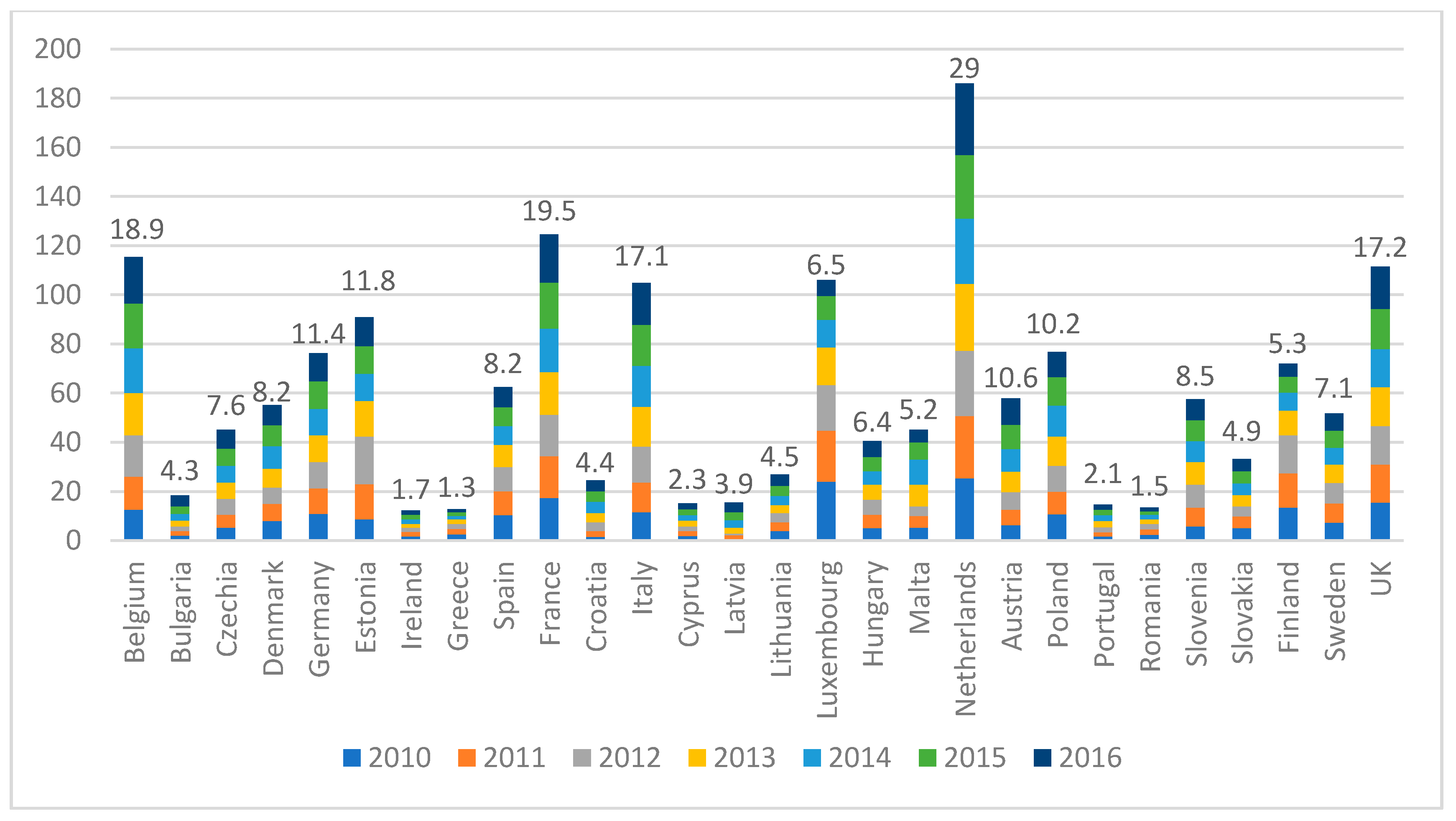
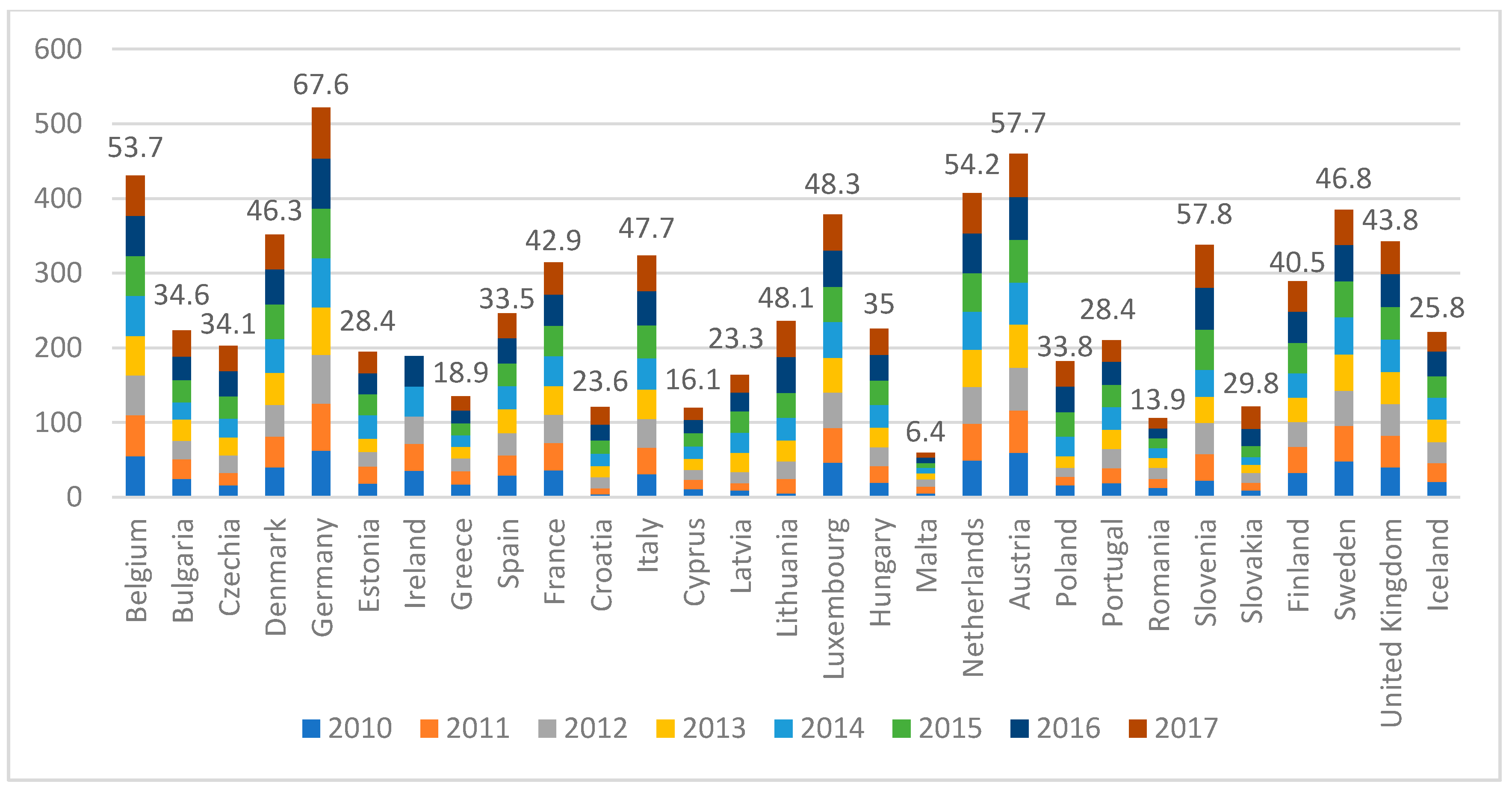
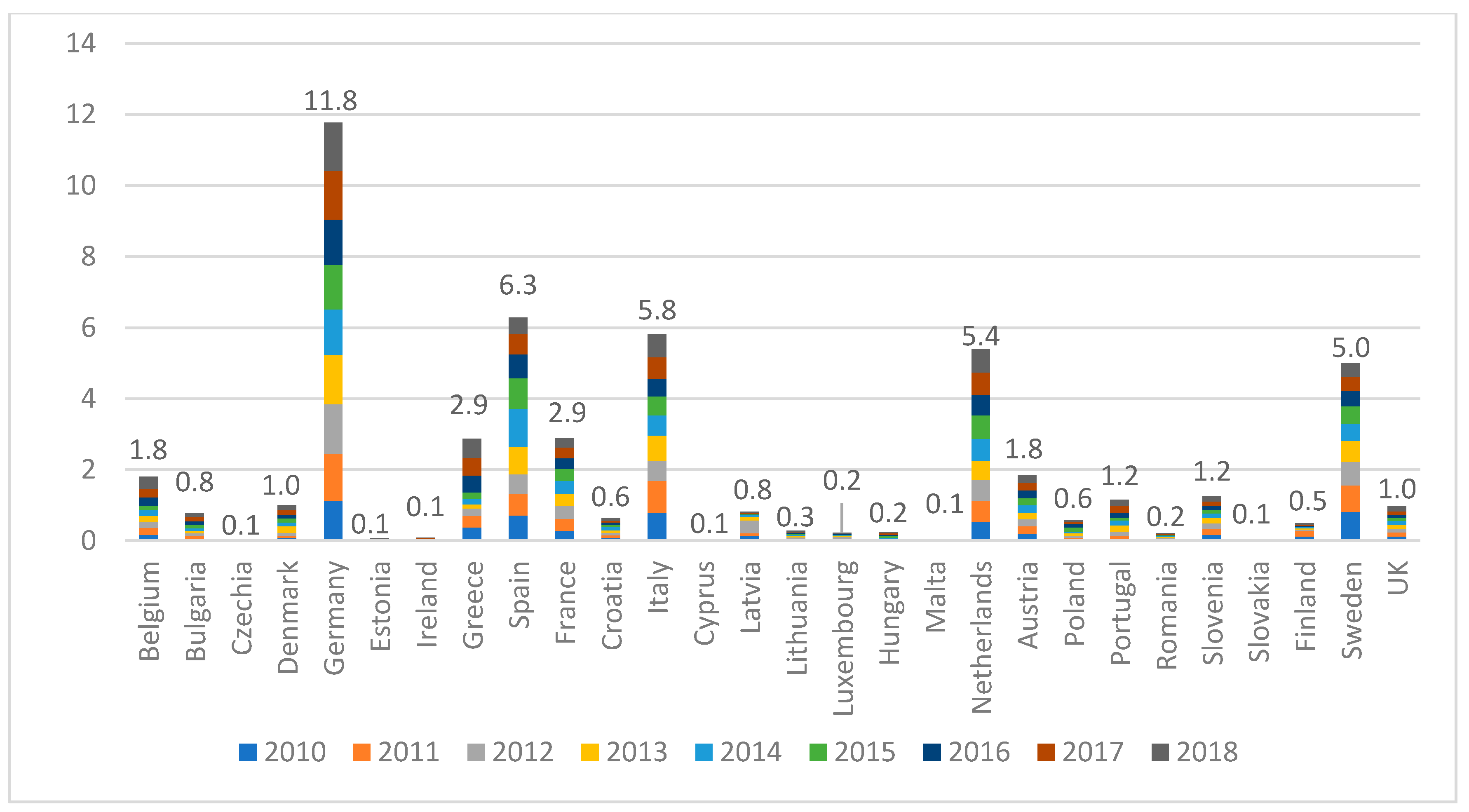
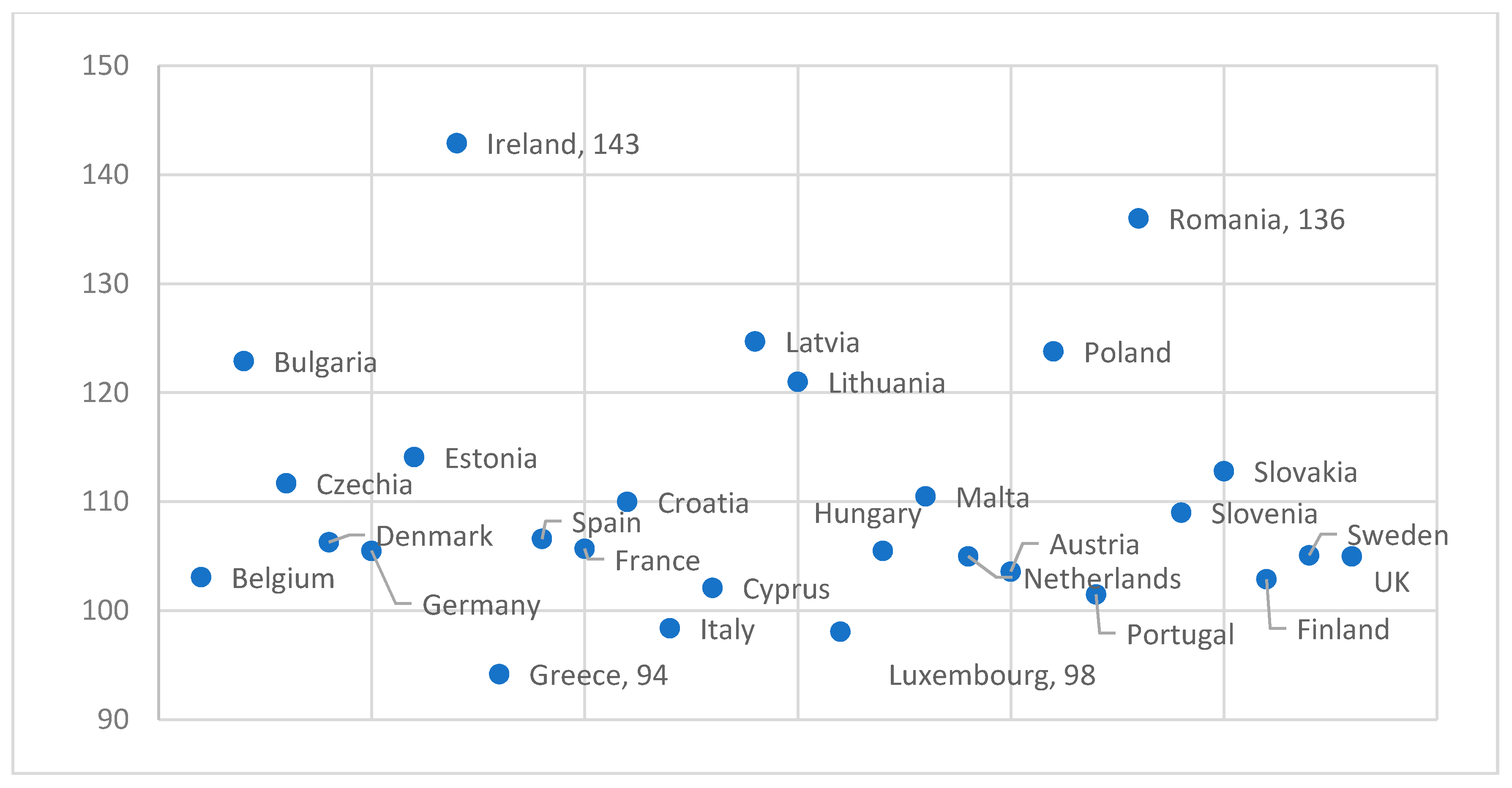
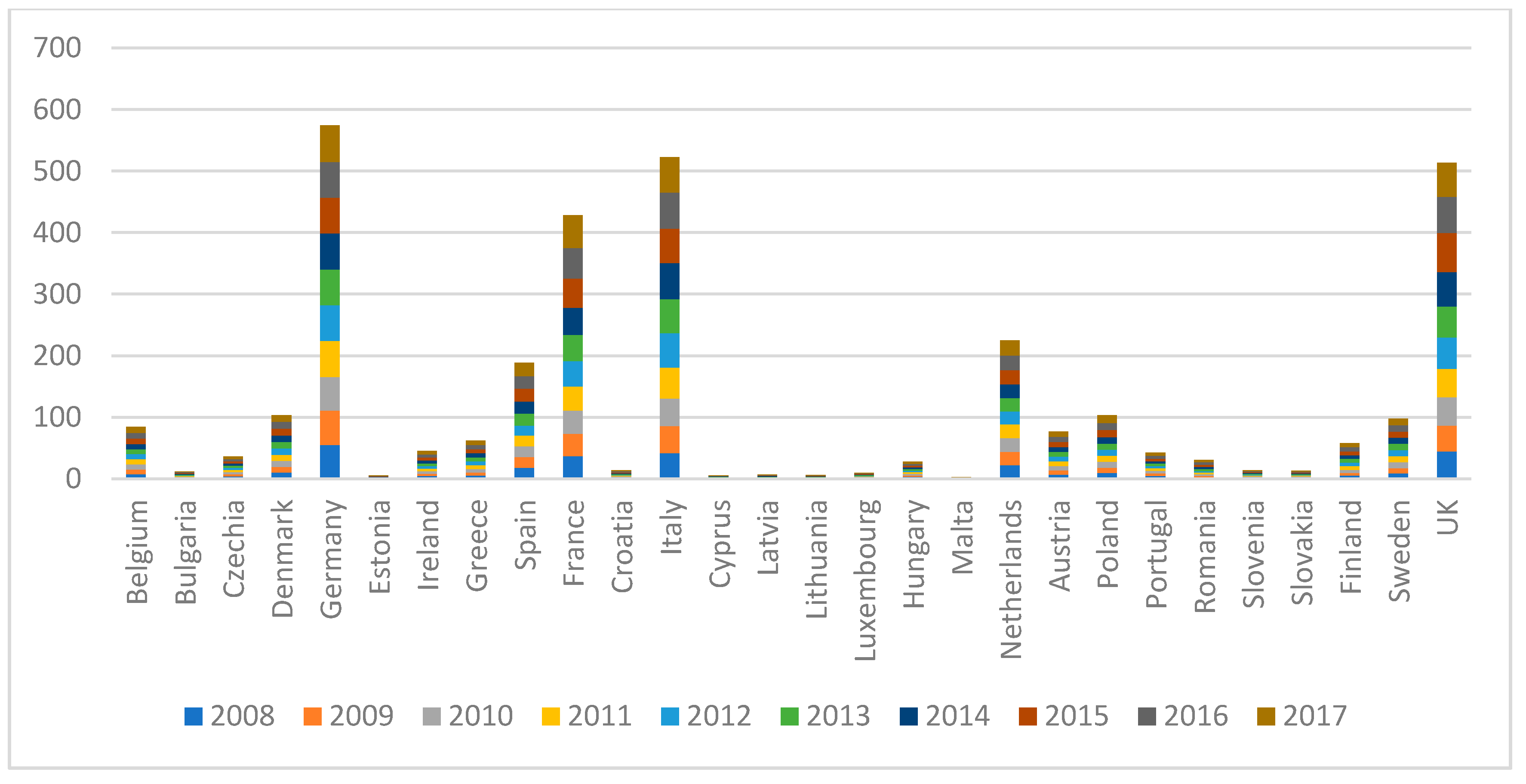
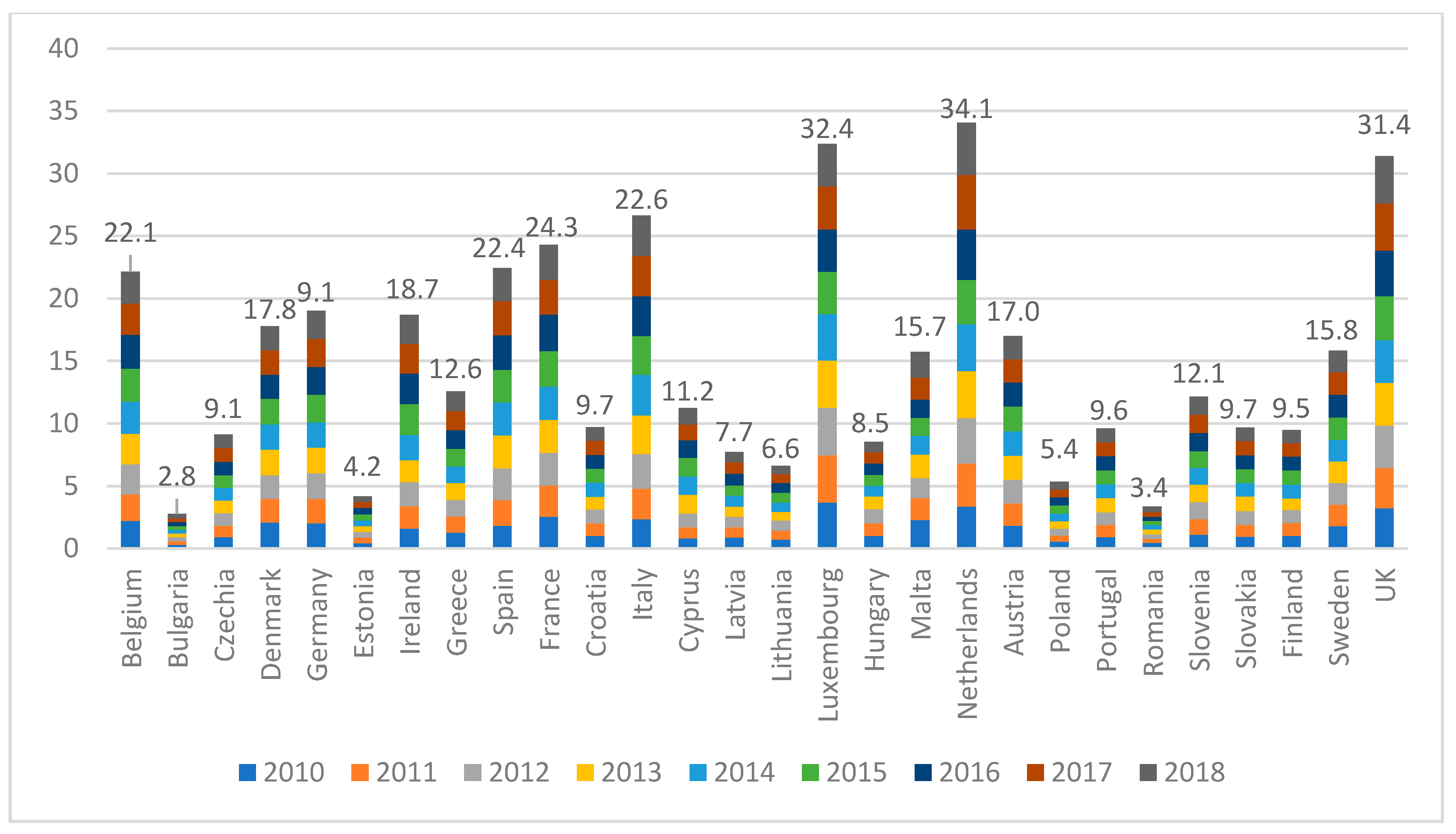
| Hypothesis Number | Hypothesis |
|---|---|
| H1 | Circular material use (CMU) rate has is strongly correlated with economic growth |
| H2 | The impact of the recycling rate of municipal waste (RRMW) on economic growth is positive and significant |
| H3 | Trade in recycling materials are strongly correlated with economic growth |
| H4 | Real labor productivity is highly correlated with economic growth |
| H5 | The impact of environmental taxes on economic growth is significant |
| H6 | Resource productivity is a significant factor of economic growth |
| Variable | Name | Definition | Unit |
|---|---|---|---|
| (Y) | GDP per capita growth | Gross domestic product increases per capita in EU member states | Percentage (%) |
| (X1) | CMU rate | The ratio of the circular use of materials to the overall material use | Percentage (%) |
| (X2) | RRMW | Measures the tonnage recycled from municipal waste divided by the total municipal waste arising | Tons |
| (X3) | Trade in recycling materials | The trade in recyclable raw materials (tons) in the EU countries | Tons |
| (X4) | Real labor productivity | The productivity per person employed in relation to EU average | Percentage (%) |
| (X5) | Environmental taxes | A tax whose base is a physical unit of something that has a proven, specific negative impact on the environment | Euro |
| (X6) | Resource productivity | Gross domestic product divided by domestic material consumption | Euro/kg |
| Variable | Min | Mean | Median | Max | St. dev. | N |
|---|---|---|---|---|---|---|
| Y | 6.981 | 30.612 | 29.084 | 118.299 | 2.229 | 27 |
| X1 | 1.300 | 8.557 | 7.800 | 29 | 6.580 | 27 |
| X2 | 6.400 | 37.178 | 34.800 | 67.600 | 14.882 | 27 |
| X3 | 0.001 | 0.211 | 0.187 | 1.350 | 0.299 | 27 |
| X4 | 94.200 | 110.286 | 106.000 | 143.000 | 11.282 | 27 |
| X5 | 0.303 | 8.171 | 7.095 | 59.259 | 18.930 | 27 |
| X6 | 0.332 | 1.731 | 1.492 | 4.173 | 1.060 | 27 |
| Variable | X1 | X2 | X3 | X4 | X5 | X6 |
|---|---|---|---|---|---|---|
| X1 | 1 | 0.134 | 0.128 | 0.212 | 0.289 | 0.283 |
| X2 | 0.134 | 1 | 0.148 | 0.207 | 0.258 | 0.198 |
| X3 | 0.128 | 0.148 | 1 | 0.149 | 0.081 | 0.246 |
| X4 | 0.212 | 0.207 | 0.149 | 1 | 0.102 | 0.269 |
| X5 | 0.289 | 0.258 | 0.081 | 0.102 | 1 | 0.174 |
| X6 | 0.283 | 0.198 | 0.246 | 0.269 | 0.174 | 1 |
| Cross Section | Time | Both | |
|---|---|---|---|
| Coefficient | 18.73 | 49.132 | 79.45 |
| Probability | 0.091 | 0.603 | 0.047 |
| Test | Value |
|---|---|
| F-statistic | 4.36 |
| Probability (F-statistic) | 0.316 |
| Dependent Variable: GDP_CAPITA_GROWTH | ||||
| Method: pooled least squares | ||||
| Sample: 2010–2017 | ||||
| Total panel observations: 216 GDP_CAPITA_GROWTH = C(1) + C(2) × CIRCULAR_MATERIAL + C(3)×MUNICIPAL_WASTE + C(4) × TRADE_MATERIALS + C(5) × LABOR_PROD+C(6) × ENVIRON_TAXES + C(7) × RESOURCE_PROD | ||||
| Coefficient | Standard Error | t-Statistic | Probability | |
| C | −12.9335 | 1.245 | 2.875409 | 0.0284 |
| CIRCULAR_MATERIAL | 0.107652 | 0.930 | 3.765092 | 0.0073 |
| MUNICIPAL_WASTE | 0.118950 | 0.848 | 2.987650 | 0.0053 |
| TRADE_MATERIALS | 0.108709 | 0.872 | 3.679802 | 0.0027 |
| LABOR_PROD ENVIRON_TAXES | 0.203765 0.097522 | 0.459 0.073 | 2.897695 3.098783 | 0.0231 0.0089 |
| RESOURCE_PROD | 0.178292 | 0.109 | ||
| R-squared | 0.776552 | Mean dependent var | 4.8762 | |
| Adjusted R-squared | 0.687378 | SD dependent var | 0.8954 | |
| Standard error (SE) of regression | 2.195433 | Akaike info criterion | 1.9034 | |
| Sum squared residual | 14.45673 | Schwarz criterion | 1.9835 | |
| Log likelihood | 82.38760 | Hannan-Quinn criterion | 1.6902 | |
| Durbin–Watson statistic | 2.187454 | |||
| Hypothesis | Valid (Yes/No) |
|---|---|
| Hypothesis 1 | Yes |
| Hypothesis 2 | Yes |
| Hypothesis 3 | Yes |
| Hypothesis 4 | Yes |
| Hypothesis 5 | Yes |
| Hypothesis 6 | Yes |
© 2019 by the authors. Licensee MDPI, Basel, Switzerland. This article is an open access article distributed under the terms and conditions of the Creative Commons Attribution (CC BY) license (http://creativecommons.org/licenses/by/4.0/).
Share and Cite
Busu, M.; Trica, C.L. Sustainability of Circular Economy Indicators and Their Impact on Economic Growth of the European Union. Sustainability 2019, 11, 5481. https://doi.org/10.3390/su11195481
Busu M, Trica CL. Sustainability of Circular Economy Indicators and Their Impact on Economic Growth of the European Union. Sustainability. 2019; 11(19):5481. https://doi.org/10.3390/su11195481
Chicago/Turabian StyleBusu, Mihail, and Carmen Lenuta Trica. 2019. "Sustainability of Circular Economy Indicators and Their Impact on Economic Growth of the European Union" Sustainability 11, no. 19: 5481. https://doi.org/10.3390/su11195481
APA StyleBusu, M., & Trica, C. L. (2019). Sustainability of Circular Economy Indicators and Their Impact on Economic Growth of the European Union. Sustainability, 11(19), 5481. https://doi.org/10.3390/su11195481






